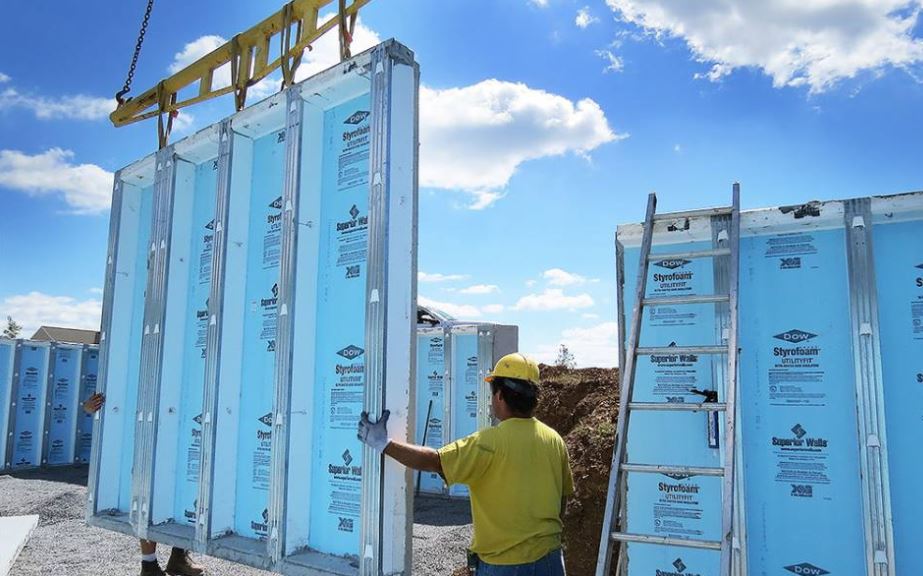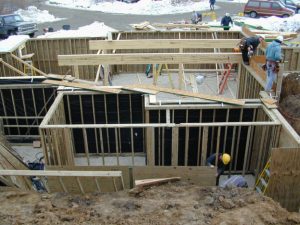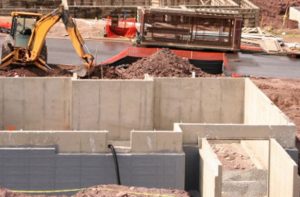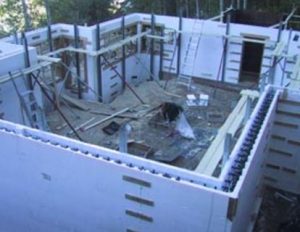Your New Home Starts with the Right Foundation


“You can’t build a great building on a weak foundation. You must have a solid foundation if you going to have a strong superstructure.”Gordon B. Hinkley
Your Home’s Foundation Works Harder Than You Think
Foundations have evolved well past their basic beginnings. They first existed to keep a home from sinking into the soil. Today, a good foundation does more than just hold up your home. A foundation is expected to resist movement in the ground around it, keep out moisture, and to insulate against the outside temperatures.
When it comes to choosing your foundation, you have several choices. Your options can be limited by the geographical area where you live, the experience of your local contractors, and as usual, your budget. Let’s explore some of the conventional foundations as well as some you probably didn’t even know existed.
Permanent Wood Foundation (PWF)
 Except for the upper-Midwest, both home buyers and builders in the rest of the U.S. have probably never even heard of a wood foundation. In fact, I bet most builders would never even think that you could build a wood foundation that meets building code. They would be wrong. Wood foundations have existed in the building codes for years. The 2015, Permanent Wood Foundation (PWF) Design Specification is adopted by reference in the 2015 International Residential Code (IRC). You can cost effectively build a wood foundation, and installed properly, it will last the lifetime of the home. However, they aren’t used outside of the Midwest.
Except for the upper-Midwest, both home buyers and builders in the rest of the U.S. have probably never even heard of a wood foundation. In fact, I bet most builders would never even think that you could build a wood foundation that meets building code. They would be wrong. Wood foundations have existed in the building codes for years. The 2015, Permanent Wood Foundation (PWF) Design Specification is adopted by reference in the 2015 International Residential Code (IRC). You can cost effectively build a wood foundation, and installed properly, it will last the lifetime of the home. However, they aren’t used outside of the Midwest.
Concrete Block
Concrete blocks, also known as Concrete Masonry Units (CMU) have actually been around for over 150 years. They first became commercially viable about 100 years ago. Over that time they became the dominant way to build a residential home foundation. After poured concrete basement technology became mainstream, they still dominated the residential foundation industry through the 1970’s. For many homes that are built today, they still one of the cheapest ways to build a basement and crawlspace foundation.
While they are cheap, there are several concerns when using them for modern home building:
- Damp Foundation – Concrete block is typically poured at 2500 PSI. Concrete is considered waterproof at 5000 PSI. This explains why moisture penetrate the concrete blocks making these type of basements feel damp giving that musty smell. Portions of the foundation that are below grade must be treated and sealed to help reduce moisture infiltration.
- Require a footer – A footer has to be formed and poured before the block can be laid. This takes time and can slow down the overall home construction process.
- Construction Timeframe – Depending on the mason, a block wall can take much more time to build than several of the other methods. It is constructed block by block entirely outdoors and its construction is subject to temperature and rain/snow.
Pour Concrete Walls
 Poured concrete walls have become the dominant foundation for today’s custom homes. In most areas, a poured concrete foundation will cost more than a concrete block wall. However, they are faster to complete reducing the opportunity for weather to delay a home building project. The process consists of:
Poured concrete walls have become the dominant foundation for today’s custom homes. In most areas, a poured concrete foundation will cost more than a concrete block wall. However, they are faster to complete reducing the opportunity for weather to delay a home building project. The process consists of:
- Dig foundation
- Form Footer (typically with inspection)
- Pour Concrete Footer
- Erect Forms
- Pour Concrete in Forms
- Remove Forms (after concrete sets up)
- Begin Construction of Home (after concrete cures)
The concrete used for a poured wall is typically rated at 3,500 PSI. This means that it can still allow moisture to penetrate the foundation walls which requires a vapor barrier and/or a sealant to be applied to the foundation.
RELATED: BRINGING CUSTOM BACK TO NEW HOME CONSTRUCTION
Poured concrete walls can be compromised in two ways when builders get in a hurry. First, a typical concrete foundation won’t reach its full strength unless left to cure for 28 days. Depending on the mix and strength, 7 days may be enough time for the concrete to cure prior to construction of the home on top of it. Another practice is to backfill the wall before the home’s floor is built on it. Without proper bracing, this can cause cracks in the wall as the soil pushes against it. A poured concrete foundation is strong. A contractor shouldn’t compromise that strength by taking shortcuts.
Superior Walls Precast Concrete Foundation System
Superior Walls is a precast concrete foundation system. It is typically only available in the U.S. east of the Mississippi River. It does have competitors such as Ideal Precast which are made slightly differently. This mean that your foundation is modular, just like your Impresa Modular Home. It is cast in pieces, delivered on a truck, and installed in a few hours. Because it is precast, it is delivered to the site, installed, and can have a home placed on it immediately after that installation (barring any required local inspections).
As a precast foundation, it is poured at 5,000 PSI. This means that the concrete is waterproof. There is no requirement to install a vapor barrier or sealant. In addition to the strength, it comes pre-insulated making them energy efficient. Variations exist to provide standard R-values at R-12.5 up to R-21.3. A Superior Wall is designed to hit the big three items a foundation needs to provide upon installation: Eliminates moisture/water in the basement, insulates the basement, and provides the highest strength of any residential home foundation.
Precast concrete is something typically found in commercial projects. Because this is also an engineered product, there are typically two questions that are asked. First, “Why doesn’t it leak when it is delivered in pieces?” and second, “It doesn’t use footers so how does it not settle on the gravel base?”
The answer to the first question is that the sections are bolted together and are bonded with an industrial style caulk/epoxy product. With a layer applied in the middle and one inside and out, the walls are guaranteed to be waterproof. As a non-engineer I look at in this way. If you break a pencil and then put it back together with superglue, the next time you break the pencil it breaks at the next weakest point in pencil. The glue is stronger. Superior Walls are engineered to be water proof and stronger than other foundations.
Next is the question about the use of a compacted gravel base instead of a concrete footer. Ask any excavator if certain locations in a foundation he has dug are harder than others. The answer is typically yes. With a footer and a concrete wall, as the softer locations settle, the poured wall can only crack as it flexes to the grounds contour. With a dynamic layer of gravel, the Superior Wall foundation system can be allowed to settle evenly reducing the stress on the wall and your home.
Insulated Concrete Forms
 Insulated Concrete Forms (ICFs) are essentially insulated concrete forms that are poured with concrete. Instead of removing the form, the foam forms have insulating value and remain on the wall. Just like a conventional poured concrete wall, they require footers. However, they save some time because there is no need to remove the forms at the end.
Insulated Concrete Forms (ICFs) are essentially insulated concrete forms that are poured with concrete. Instead of removing the form, the foam forms have insulating value and remain on the wall. Just like a conventional poured concrete wall, they require footers. However, they save some time because there is no need to remove the forms at the end.
ICFs allow you to complete the exterior of the foundation with stucco or stone. In addition, the insulating value of the foam improves the energy efficiency of this system. The tricky part comes in waterproofing the ICF foundation. It is critical to get this part right because the nature of the stacked forms makes it difficult to seal every channel and crack in the forms themselves.
Slab-on-grade
As the name suggests, a slab-on-grade foundation is just that. It is a poured concrete slab placed directly on the ground. Because there is no crawlspace or basement, utilities are typically placed under or within the slab. This type of foundation is cheap to build and very popular in the southern states. It is used where the ground does not freeze.
While it is a low cost foundation, in its conventional form, it isn’t used for homes using modular construction because of the need to access and connect utilities under the home. When utilities fail (i.e. leaks in plumbing), the floor needs to be cut up in the home to find and replace the broken pipes.
Which Foundation is Right for You and Your Home?
When it comes to deciding which foundation is right for you, some of it depends on your location and much of it depends on your budget. Most homes today are placed on poured concrete walls. They are stronger than concrete block walls and typically faster to install. Engineered wall systems, where they are available, are making inroads in the market because of their speed of installation, waterproof construction, and energy efficiency.
Do your research and evaluate the costs. Your homes foundation is critical to the long term health and durability of your home. Install your home on the best foundation you can afford when building your new home.
The post Your New Home Starts with the Right Foundation appeared first on Impresa Modular.




